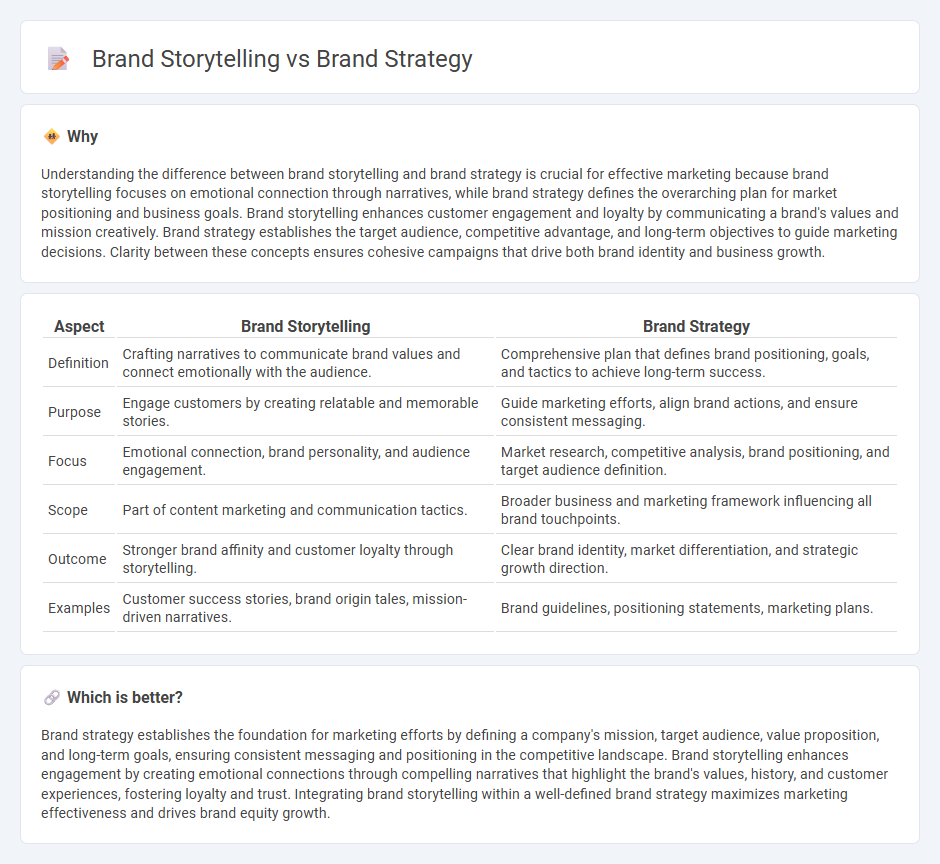
Brand storytelling focuses on creating a compelling narrative that emotionally connects consumers with a brand, emphasizing authenticity and memorable experiences. Brand strategy involves a comprehensive plan that defines a brand's purpose, values, target audience, and market positioning to drive long-term growth and competitive advantage. Explore how balancing these elements can elevate your marketing efforts and strengthen brand equity.
Why it is important
Understanding the difference between brand storytelling and brand strategy is crucial for effective marketing because brand storytelling focuses on emotional connection through narratives, while brand strategy defines the overarching plan for market positioning and business goals. Brand storytelling enhances customer engagement and loyalty by communicating a brand's values and mission creatively. Brand strategy establishes the target audience, competitive advantage, and long-term objectives to guide marketing decisions. Clarity between these concepts ensures cohesive campaigns that drive both brand identity and business growth.
Comparison Table
| Aspect | Brand Storytelling | Brand Strategy |
|---|---|---|
| Definition | Crafting narratives to communicate brand values and connect emotionally with the audience. | Comprehensive plan that defines brand positioning, goals, and tactics to achieve long-term success. |
| Purpose | Engage customers by creating relatable and memorable stories. | Guide marketing efforts, align brand actions, and ensure consistent messaging. |
| Focus | Emotional connection, brand personality, and audience engagement. | Market research, competitive analysis, brand positioning, and target audience definition. |
| Scope | Part of content marketing and communication tactics. | Broader business and marketing framework influencing all brand touchpoints. |
| Outcome | Stronger brand affinity and customer loyalty through storytelling. | Clear brand identity, market differentiation, and strategic growth direction. |
| Examples | Customer success stories, brand origin tales, mission-driven narratives. | Brand guidelines, positioning statements, marketing plans. |
Which is better?
Brand strategy establishes the foundation for marketing efforts by defining a company's mission, target audience, value proposition, and long-term goals, ensuring consistent messaging and positioning in the competitive landscape. Brand storytelling enhances engagement by creating emotional connections through compelling narratives that highlight the brand's values, history, and customer experiences, fostering loyalty and trust. Integrating brand storytelling within a well-defined brand strategy maximizes marketing effectiveness and drives brand equity growth.
Connection
Brand storytelling enhances brand strategy by creating emotional connections and conveying the brand's core values through compelling narratives. Effective storytelling shapes brand identity, differentiates from competitors, and drives customer loyalty by making the brand memorable. Integrating storytelling into brand strategy aligns marketing efforts with audience engagement, fostering a consistent and impactful brand presence.
Key Terms
Brand Strategy:
Brand strategy defines the long-term plan for building a strong brand identity, aligning business goals with customer perceptions and market positioning to ensure consistent messaging across all touchpoints. It involves targeted audience analysis, competitive differentiation, value propositions, and measurable objectives to enhance brand equity and drive loyalty. Discover more about how a robust brand strategy can transform your business success.
Positioning
Brand strategy centers on positioning by defining a unique market space, targeting specific customer segments, and creating a consistent brand message that differentiates from competitors. Brand storytelling enhances this positioning by crafting compelling narratives that evoke emotional connections and reinforce brand values, making the message memorable and relatable. Explore how integrating both approaches can elevate your brand's market presence and customer loyalty.
Value Proposition
Brand strategy defines the core value proposition by positioning a brand's unique benefits and differentiators in the marketplace, driving targeted customer engagement and long-term loyalty. Brand storytelling brings this value proposition to life through compelling narratives that emotionally connect with audiences, enhancing brand recall and trust. Explore how combining strategic positioning with authentic storytelling amplifies your brand's impact.
Source and External Links
What Is Brand Strategy? Definition and Guide (2024) - Shopify - A brand strategy is a holistic approach for building identification and favorability with customers, centered around key elements such as brand story, voice, identity design, values, and vibe.
The Ultimate Guide to Brand Strategy - Adobe - Building a brand strategy involves identifying your target audience, establishing a unique market position, and crafting a compelling brand narrative to connect deeply with customers' needs and preferences.
Creating a Brand Strategy: 8 Essentials & Templates for 2025 - Visme - A brand strategy is an actionable plan to build rapport, differentiate from competitors, and expand through techniques like brand extension, leveraging the existing brand's strength to enter new markets or categories.
 dowidth.com
dowidth.com